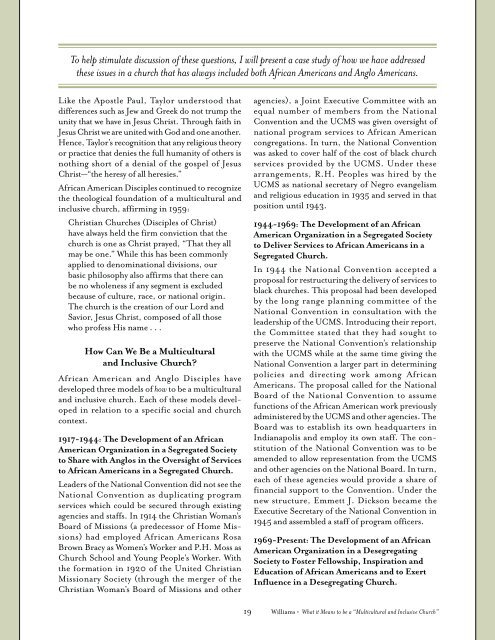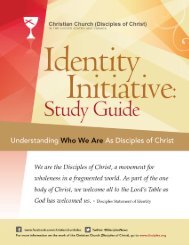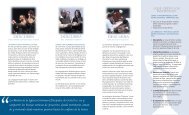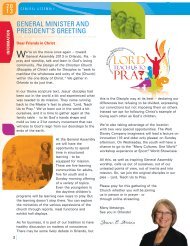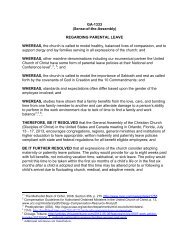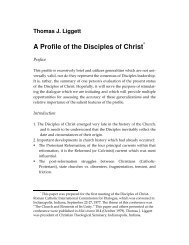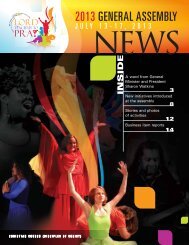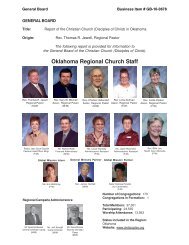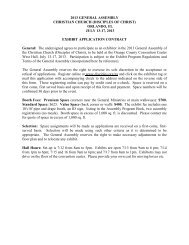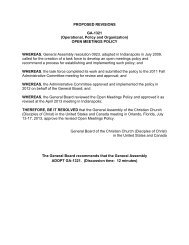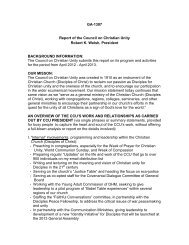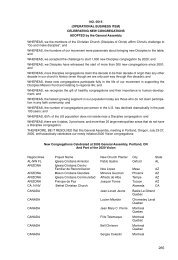RESOURCING THE CHURCH FOR ECUMENICAL MINISTRy A ...
RESOURCING THE CHURCH FOR ECUMENICAL MINISTRy A ...
RESOURCING THE CHURCH FOR ECUMENICAL MINISTRy A ...
You also want an ePaper? Increase the reach of your titles
YUMPU automatically turns print PDFs into web optimized ePapers that Google loves.
To help stimulate discussion of these questions, I will present a case study of how we have addressed<br />
these issues in a church that has always included both African Americans and Anglo Americans.<br />
Like the Apostle Paul, Taylor understood that<br />
differences such as Jew and Greek do not trump the<br />
unity that we have in Jesus Christ. Through faith in<br />
Jesus Christ we are united with God and one another.<br />
Hence, Taylor’s recognition that any religious theory<br />
or practice that denies the full humanity of others is<br />
nothing short of a denial of the gospel of Jesus<br />
Christ—“the heresy of all heresies.”<br />
African American Disciples continued to recognize<br />
the theological foundation of a multicultural and<br />
inclusive church, affirming in 1959:<br />
Christian Churches (Disciples of Christ)<br />
have always held the firm conviction that the<br />
church is one as Christ prayed, “That they all<br />
may be one.” While this has been commonly<br />
applied to denominational divisions, our<br />
basic philosophy also affirms that there can<br />
be no wholeness if any segment is excluded<br />
because of culture, race, or national origin.<br />
The church is the creation of our Lord and<br />
Savior, Jesus Christ, composed of all those<br />
who profess His name . . .<br />
How Can We Be a Multicultural<br />
and Inclusive Church?<br />
African American and Anglo Disciples have<br />
developed three models of how to be a multicultural<br />
and inclusive church. Each of these models developed<br />
in relation to a specific social and church<br />
context.<br />
1917-1944: The Development of an African<br />
American Organization in a Segregated Society<br />
to Share with Anglos in the Oversight of Services<br />
to African Americans in a Segregated Church.<br />
Leaders of the National Convention did not see the<br />
National Convention as duplicating program<br />
services which could be secured through existing<br />
agencies and staffs. In 1914 the Christian Woman’s<br />
Board of Missions (a predecessor of Home Missions)<br />
had employed African Americans Rosa<br />
Brown Bracy as Women’s Worker and P.H. Moss as<br />
Church School and Young People’s Worker. With<br />
the formation in 1920 of the United Christian<br />
Missionary Society (through the merger of the<br />
Christian Woman’s Board of Missions and other<br />
19<br />
agencies), a Joint Executive Committee with an<br />
equal number of members from the National<br />
Convention and the UCMS was given oversight of<br />
national program services to African American<br />
congregations. In turn, the National Convention<br />
was asked to cover half of the cost of black church<br />
services provided by the UCMS. Under these<br />
arrangements, R.H. Peoples was hired by the<br />
UCMS as national secretary of Negro evangelism<br />
and religious education in 1935 and served in that<br />
position until 1943.<br />
1944-1969: The Development of an African<br />
American Organization in a Segregated Society<br />
to Deliver Services to African Americans in a<br />
Segregated Church.<br />
In 1944 the National Convention accepted a<br />
proposal for restructuring the delivery of services to<br />
black churches. This proposal had been developed<br />
by the long range planning committee of the<br />
National Convention in consultation with the<br />
leadership of the UCMS. Introducing their report,<br />
the Committee stated that they had sought to<br />
preserve the National Convention’s relationship<br />
with the UCMS while at the same time giving the<br />
National Convention a larger part in determining<br />
policies and directing work among African<br />
Americans. The proposal called for the National<br />
Board of the National Convention to assume<br />
functions of the African American work previously<br />
administered by the UCMS and other agencies. The<br />
Board was to establish its own headquarters in<br />
Indianapolis and employ its own staff. The constitution<br />
of the National Convention was to be<br />
amended to allow representation from the UCMS<br />
and other agencies on the National Board. In turn,<br />
each of these agencies would provide a share of<br />
financial support to the Convention. Under the<br />
new structure, Emmett J. Dickson became the<br />
Executive Secretary of the National Convention in<br />
1945 and assembled a staff of program officers.<br />
1969-Present: The Development of an African<br />
American Organization in a Desegregating<br />
Society to Foster Fellowship, Inspiration and<br />
Education of African Americans and to Exert<br />
Influence in a Desegregating Church.<br />
Williams • What it Means to be a “Multicultural and Inclusive Church”


